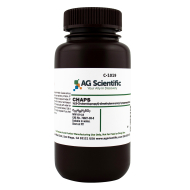Here we cover 18 fast facts about CHAPS detergent.
1. What are biodetergents?
Biodetergents are soluble amphiphilic molecules that are able to incorporate to liposomes and cell membranes. They are essential tools for the study of biological membranes, as they are frequently used to solubilize membrane proteins and to investigate the interactions among membrane lipid components.
2. What are the different types of biological detergents?
- Ionic detergents Have a hydrophilic group that has a net charge.
- Non-Ionic detergents They have an uncharged hydrophilic head group.
- Zwitterionic detergents These detergents have combined properties of ionic and non-ionic Detergents.
3. How do Detergents work?
The process of detergent solubilization of proteins involves three steps. The first is the partition of detergent molecules between the aqueous medium and the membrane at low, sub-solubilizing concentrations. The second, is the gradual incorporation of membrane lipids into detergent/lipid mixed micelles. The third, when all the membrane lipids are solubilized into detergent micelles, is the gradual enrichment of mixed micelles in detergent, upon detergent increase.
4. What are Micelles?
Micelles are spherical structures formed by detergents. Micelles are formed by the aggregation of detergent molecules that are analogous to the bilayer of the biological membranes.
5. What is CHAPS Detergent?
CHAPS is a zwitterionic detergent, a derivative of the bile salts that is widely used in membrane protein solubilization. It is a “facial†detergent, having a hydrophilic side and a hydrophobic back.
6. What does the abbreviation CHAPS stand for?
CHAPS is an abbreviation for 3-[(3-cholamidopropyl) dimethylammonio]-1-propanesulfonate.
7. Why is CHAPS called zwitterionic?
CHAPS is called zwitterionic due to its quaternary ammonium and sulfonate groups; it is structurally similar to certain bile acids, such as taurodeoxycholic acid and taurochenodeoxycholic acid.
8. What is the chemical structure of CHAPS?
CHAPS detergent, has a ring steroid-type chemical structure similar to that of bile salts, having a hydrophilic side where three OH groups protrude, and a hydrophobic back. It is very effective at breaking protein protein interactions, disaggregating protein complexes without affecting secondary or tertiary structures.
9. What is an aggregation number?
An aggregation number is a physical property of the micelle formed by the detergent. It represents the number of detergent monomers present within a micelle. With knowledge of the detergent CMC (critical micelle concentration) and aggregation number, one can determine several important parameters including the concentration of micelles present in solution and the aggregate molecular weight of the micelle.
10. What is the aggregation number of CHAPS detergent?
CHAPS has an aggregation number of approximately 10.
11. What is critical micelle concentration (CMC)?
Critical Micelle Concentration (CMC) is an important parameter that determines the selection of a detergent for an application. At CMC the detergent molecules begin to accumulate at the membrane.
12. What is the CMC for CHAPS?
The critical micelle concentration of CHAPS is 6-10mM.
13. What is the Molecular weight of CHAPS?
The molecular weight of CHAPS is 614.9 g/mol
14. What is the appearance of CHAPS?
CHAPS appears as White Powder
15. What is the storage temperature of CHAPS?
CHAPS should be stored desiccated at room temperature (+20°C). *To ensure stability of the product, follow the manufacturers storage and handling instructions.
16. What are the applications of CHAPS?
CHAPS is used as a nondenaturing solvent in the process of protein purification and is especially useful in purifying membrane proteins, which are often sparingly soluble or insoluble in aqueous solution due to their natively hydrophobic cellular environment. When in salt, CHAPS tends to behave as a weakly charged cation. However, in water or buffer, it behaves as a nonionic surfactant.
17. In what type of applications should I use CHAPS?
CHAPS is ideally used for chromatography, mass spectrometry, isoelectric focusing and 2D electrophoresis as well as for solubilization of organelles and inclusion bodies since they do not alter the native charge of the protein molecules.
18. How easy is it to remove excess of CHAPS from my application?
CHAPS is a high CMC detergent that can be easily removed by dialysis while those with low CMCs are typically removed by adsorption to hydrophobic beads.
